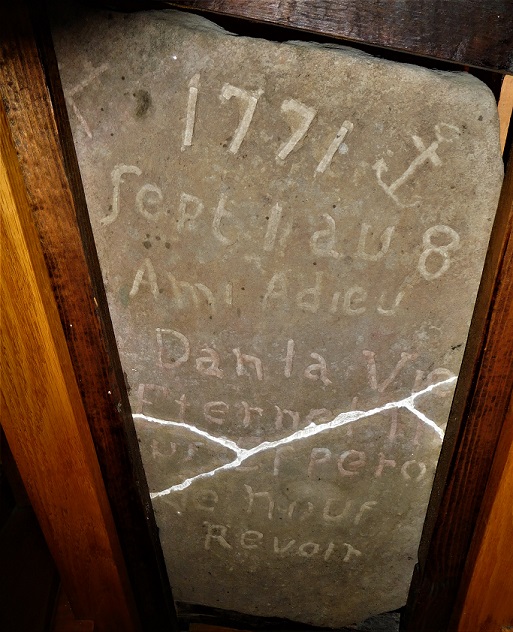First Nation peoples inhabited Clearfield County, off and on, for 10,000 years. Exploration and settlement by Euro Americans are documented back to the 1780’s and into the early years of the 19th century.
How does a tombstone, accidently unearthed in 1896, by a farmer’s plow, in Covington Township, near what is today Frenchville enter into county’s historical picture?
The photos show both sides of a hand-chiseled sandstone grave marker, dated 1771 and written in French. The date is over a half-century before French immigrants from the Haute Saone region of France began arriving in the “down river” area of the county. They bore no relationship to the remains lying beneath the stone.
Research has shown that the stone marked the final resting place of Tohas Auxe, a Catholic priest of the Jesuit order, who, likely with companions, was travelling through that northeastern part of Clearfield County and died along the way.
The front side of the stone reads, “A la memoir de Tohas Auxe 35 R.J.” Was Tohas Auxe 35 years of age? Was R.J. the man who carved the inscription?
The flip side of the stone says, “1771 1 au 8 Septembre. Ami au revior dans la vie eternelle, nous esperons nous revoir”. (Friend goodbye in eternal life we hope to meet again”).
A small unearthed footstone reveals the words, “1771 Vosges Epinal T.A.”. Vosges is a small French city located in that nation’s eastern mountainous foothills, Auxe’s likely birthplace.
Small ship’s anchors are also carved into both sides of the stone. Were his priestly companion’s experienced stone carvers and seaman?
Past historians, including George Scott, at one time president of the Clearfield County Historical Society, have put forth the likely explanation, based on competent research that Auxe and his companions, including two Native American guides, were making the long and dangerous trek, through much of continental North America, from Quebec to New Orleans.
British control of Quebec and New France, after their occupation in 1763, often was accompanied by repression of the French-Canadian populace, forcing some to vacate the province.
In an almost incredible feat of physical endurance, the party began to walk through the dense wilderness. They could, by canoe, travel down the North Branch of the Susquehanna River to what is now Sunbury, and then up the West Branch to the river’s headwaters.
The tough part of the trip would be to scale the Allegheny Mountains, in order to reach the tributaries of the Allegheny River, where the water flows westward, to the forks of the Ohio River in present-day Pittsburgh.
From there, they could follow the all water route, for thousands of miles, down the Ohio and Mississippi Rivers, to New Orleans on the Gulf of Mexico.
Tohas Auxe never made it. Apparently, he died of a feverish disease, likely caused by mosquitoes or flies. He was buried where he died.
A few local historians have speculated that this trek from Canada to New Orleans, by way of Clearfield County, could have been a somewhat more routine than this one event.
The pieces of grave stone have been caulked together and framed. It is on display at the Clearfield county Historical Society’s Alexander Research Center.
